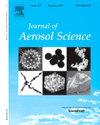Spray flame synthesis of Y2O3/Al2O3 composite nanoparticles: Effects of precursor volatility and Y/Al ratio on particle morphology and crystal phase
IF 3.9
3区 环境科学与生态学
Q2 ENGINEERING, CHEMICAL
引用次数: 0
Abstract
Spray flame synthesis has proven to be a promising method for the high-throughput production of multi-component nanoparticles with atomic-level mixing. However, the fast dynamic of flame synthesis presents significant challenges in precisely controlling the morphology and crystalline phase of the particles, especially for multi components. In this paper, we conduct parametric flame synthesis experiments to identify key factors affecting nanoparticle morphology and crystal phase of Y-Al nanoparticles, focusing on the effects of Y/Al atomic ratio, flame temperature, and precursor volatility. The results indicate that the particle morphology depends on the composition, changing from aggregates with sintering necks to spherical particles without sintering necks and back to aggregates as the Al content increases. This trend is consistent with the change in particle melting points, which initially decrease and then rise again. Thus, the variation in melting point causes changes in sintering time, which in turn affect the particle morphology. The particle crystalline phase gradually deviates from the target phase as the Al content increases. Raising the adiabatic flame temperature from 1551 °C to 2340 °C accelerates the diffusion of Al atoms into the lattice, increasing the target phase proportion in the synthesized particles from 66 % to 99 %. By adjusting the amount of 2-ethylhexanoic acid (EHA) added, the volatility differences between the precursors can be modified. The largest discrepancy in precursor volatility is observed when EHA was added at a 50 % equivalence ratio, resulting in only 6 % of the target phase YAH (YAlO3, hexagonal type) in the particles. Increasing the EHA addition to 120 % equivalent results in better matching of precursor volatilities, which leads to a significant increase in the target YAH phase to 98 %, demonstrating the critical role of simultaneous evaporation of different component precursors.
喷雾火焰合成Y2O3/Al2O3复合纳米颗粒:前驱体挥发性和Y/Al比对颗粒形貌和晶相的影响
喷雾火焰合成是一种极有前途的制备多组分原子级混合纳米粒子的高通量方法。然而,火焰合成的快速动力学对精确控制颗粒的形态和晶相提出了重大挑战,特别是对于多组分的颗粒。本文通过参数火焰合成实验,确定影响Y-Al纳米颗粒形貌和晶相的关键因素,重点研究Y/Al原子比、火焰温度和前驱体挥发性的影响。结果表明:随着Al含量的增加,颗粒形貌随组分的增加而变化,从有烧结颈的团聚体变为无烧结颈的球形颗粒,再变为团聚体。这一趋势与颗粒熔点的变化是一致的,颗粒熔点先下降后上升。因此,熔点的变化引起烧结时间的变化,进而影响颗粒形态。随着Al含量的增加,颗粒晶相逐渐偏离目标相。将绝热火焰温度从1551℃提高到2340℃,加速了Al原子向晶格中的扩散,使合成颗粒中的靶相比例从66%提高到99%。通过调整2-乙基己酸(EHA)的加入量,可以改变前驱体之间的挥发性差异。当EHA以50%的当量比加入时,前驱体挥发性差异最大,导致颗粒中只有6%的目标相YAH (YAlO3,六边形型)。将EHA添加量增加到120%当量时,前驱体挥发性匹配更好,从而使目标YAH相显著增加到98%,证明了不同组分前驱体同时蒸发的关键作用。
本文章由计算机程序翻译,如有差异,请以英文原文为准。
求助全文
约1分钟内获得全文
求助全文
来源期刊

Journal of Aerosol Science
环境科学-工程:化工
CiteScore
8.80
自引率
8.90%
发文量
127
审稿时长
35 days
期刊介绍:
Founded in 1970, the Journal of Aerosol Science considers itself the prime vehicle for the publication of original work as well as reviews related to fundamental and applied aerosol research, as well as aerosol instrumentation. Its content is directed at scientists working in engineering disciplines, as well as physics, chemistry, and environmental sciences.
The editors welcome submissions of papers describing recent experimental, numerical, and theoretical research related to the following topics:
1. Fundamental Aerosol Science.
2. Applied Aerosol Science.
3. Instrumentation & Measurement Methods.
 求助内容:
求助内容: 应助结果提醒方式:
应助结果提醒方式:


